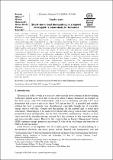| dc.contributor.author | Mbuya, Benson | |
| dc.contributor.author | Moncecchi, Matteo | |
| dc.contributor.author | Merlo, Marco | |
| dc.contributor.author | Kivevele, Thomas | |
| dc.date.accessioned | 2020-06-10T07:27:29Z | |
| dc.date.available | 2020-06-10T07:27:29Z | |
| dc.date.issued | 2019 | |
| dc.identifier.uri | https://dspace.nm-aist.ac.tz/handle/20.500.12479/775 | |
| dc.description | This research article published by the Journal of Electrical Systems; Vol. 15, Iss. 4, (2019) | en_US |
| dc.description.abstract | Most emerging countries such as Tanzania are promoting rural electrification through
installation of microgrids. This paper proposes an approach for short-term day-ahead load
forecast in rural hybrid microgrids in emerging countries. Energy4Growing research project by
Politecnico di Milano department of energy in collaboration with EKOENERGY
(www.ekoenergy.org) implemented in Ngarenanyuki Secondary School (Arusha, Tanzania)
innovative control switchboards to form an energy smart-hub. The smart-hub was designed to
manage the school’s 10kW hybrid micro-grid comprising: PV-inverter, battery storage, microhydro system, and genset. Ngarenanyuki school microgrid’s data was used for the experimental
short-term load forecast in this case study. A short-term load forecast model framework
consisting of hybrid feature selection and prediction model was developed using MATLAB©
environment. Prediction error performance evaluation of the developed model was done by
varying input predictors and using the principal subset features to perform supervised training
of 20 different conventional prediction models and their hybrid variants. The objective function
was feature minimization and error performance optimization. The experimental and
comparative day-ahead load forecast analysis performed showed the importance of using
different feature selection algorithms and formation of hybrid prediction models approach to
optimize overall prediction error performance. The proposed principal k-features subset union
approach registered low error performance values than standard feature selection methods when
it was used with ‘linearSVM’ prediction model. Furthermore, a hybrid prediction model formed
from the elementwise maximum forecast instances of two regression models (‘linearSVM’ and
‘cubicSVM’) yielded better MAE prediction error than the individual regression models fused to
form the hybrid. | en_US |
| dc.language.iso | en | en_US |
| dc.publisher | Journal of Electrical Systems | en_US |
| dc.subject | Load forecast | en_US |
| dc.subject | Feature selection | en_US |
| dc.subject | Hybrid micro-grid | en_US |
| dc.subject | Emerging countries | en_US |
| dc.title | Short-term load forecasting in a hybrid microgrid: a case study in Tanzania | en_US |
| dc.type | Article | en_US |

